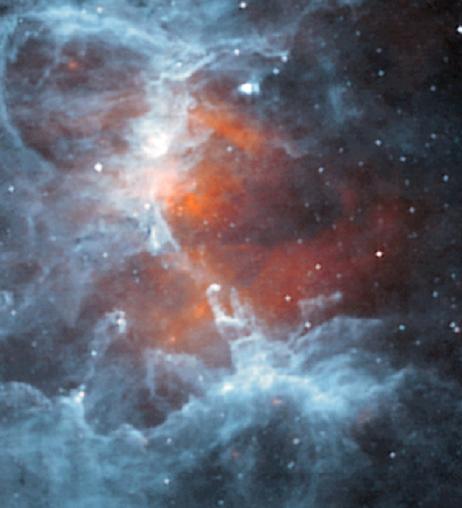
Stephen's daily gem: Cold Dust Or Glowing Plasma.
Rather than frigid clouds of dust and gas, spiraling filaments suggest electric currents in space.
Dust at a temperature near absolute zero shows up in the infrared image above as a blue fog deep in the heart of the Eagle nebula. The Eagle nebula is an active "star nursery" located in the constellation Serpens, approximately 7000 light-years away. It is a multi-spectral cloud of gas mixed with microscopic particles of dust.
The consensus view is that cold dust is a necessary ingredient when stars condense out of nebulae. When gas and dust start to collapse into a new star it naturally warms up and radiates energy. As the theory states, outward pressure is created that opposes the inward force of gravity. If the outward force wins and overcomes the force of gravity, the atoms in the gas will never be compressed enough to undergo nuclear fusion. However, if the dust in the nebula is cold enough, it allows the heat created in the gravitational collapse to be radiated away, therefore a new star can ignite.
On the other hand, when the Electric Universe theory is considered, cold nebulae are evidence of electrical activity even at temperatures near absolute zero. Bipolar symmetry is typical of most nebulae, and most of them are dense enough to emit light because they are extremely hot in some regions. But the middle of the Eagle nebula is cold: radio measurements indicate the dust clouds around the inner part are only one degree above absolute zero. We are able to see the center of the nebula because dust particles reflect light from the star.
The filamentary structure of the "fingers" and the way the filaments spiral away from the central stars indicates Birkeland currents, named after Kristian Birkeland, who first proposed their existence in the late 1800s. These currents form scalable tubes of plasma that can transmit electric power all around the galaxy. Electromagnetic forces sometimes cause them to pinch down to smaller and smaller sizes. Plasma confined within the center of the pinch is crushed and increases in current density until the so-called "z-pinch" produces a star. Plasma surrounding the star will often glow as an "emission nebula," but in some conditions of opacity and density the surrounding plasma can be cold, as in the Eagle Nebula, revealing its presence only in infrared light.
Conventional astronomers do not know how stars throw off clouds of gas and dust that eventually become other stars because stars are not made of gas and dust. A star is the focus of Birkeland currents that make up circuits flowing around the galaxy. The electromagnetic pinch that squeezes plasma into the star also forms a toroidal current around the star’s equator. The density of the current causes the plasma in the ring to glow. The Electric Universe explanation is that we are looking at plasma structures when we look at nebulae, and they behave according to the laws of electrical discharges and circuits.
Instead of mechanical action and cold gas, the Orion Nebula’s radiant new stars were created in a boost of electric current. It is not necessary to prevent young stars from heating up by shielding them in cold dust. The electrical sheath around a new star receives input from the galactic Birkeland currents in which it is immersed and gets pushed into the "glow" discharge state. Gravity has little if anything to do with the processes of star formation.














3 comments:
Dust is often times ionized, but it is not necessarily plasma. The difference is in the number of electrons that have been stripped away from the atomic nucleus. It is most likely ionized dust and gas that we're looking at, the more electrons stripped the hotter the gas and dust needs to be. That temperature is something that can be deduced by photospectral analysis, based on the average frequency of the photons.
QF,
"Dust is often times ionized, but it is not necessarily plasma"
Plasma is often times dust, but it is not necessarily dust.
I think there is a technical difference between dust and plasma, mainly having to do with temperature and charge density. Heat ionized dust up significantly and you'll get plasma. Plasma is the term used for loose electrons, unbounded atomic nucleuses, and free subatomic particles with temperatures increasing in that order.
In my mind, dust is mostly loosely supsended clumps of ionized material in a gaseous medium, typically of larger than the nanometer scale up to millimeter size, which typically settles under a gravitational field or is drawn towards/away from electrostatic fields.
Post a Comment